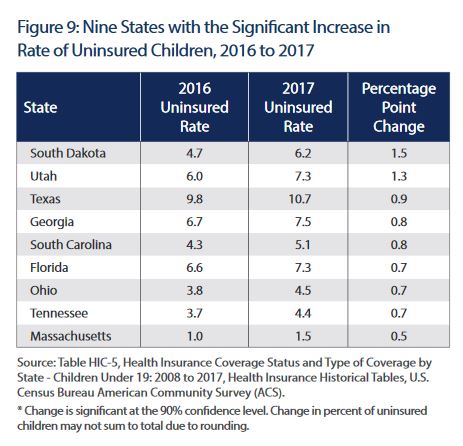Georgetown University Health Policy Institute released a report last month on the nation’s progress on children’s health and access to health insurance. The report has some interesting key findings, but the premise of the story is children are losing access to health insurance and for the first time since 2008, the nation’s steady progress on increasing access to health insurance actually declined.
The study states children under the age of 19 without health insurance rose to 3.9 million in 2017 and nine states saw “significant” increases in uninsured children. South Dakota tops that list with Utah, Texas, Georgia, South Carolina, Florida, Ohio, Tennessee and Massachusetts close behind. A graph in the report details the 2016 uninsured rate in South Dakota being only 4.7 percent, while the 2017 uninsured rate rose to 6.2 percent.

Access to health care and health insurance is particularly important in children as it means well-child checkups and vaccinations. Studies in the past have also shown that when children have access to health care there are increases in educational outcomes, as well as long-term health and economic success.
The interesting twist on this Georgetown report is the South Dakota’s Children’s Health Insurance Program (CHIP) and children’s Medicaid program have both been experiencing dramatic declines in enrollment. The state of South Dakota isn’t enrolling as many children. Let’s take an even deeper dive into what drives numbers in South Dakota. The eligibility for access to CHIP or child Medicaid have not changed. CHIP’s income eligibility has been set at 209 percent of the federal poverty level (FPL) and child Medicaid is 182 percent of FPL.
But what does that mean to the average South Dakota family? The South Dakota income eligibility for calendar year 2018 for a family of four for CHIP is $52,459 and child Medicaid is $45,682. According to the American Community Survey (ACS) the median household income is $54,467, the median family income is $70,853 and the median per capita income is $28,585. See Medical Services Data and Trends.
Observation: South Dakota is reporting more uninsured children with declining enrollments in the state’s CHIP and child Medicaid programs. South Dakota is either not capturing and enrolling the children that are eligible for the programs or the South Dakota family and household incomes have risen to the point where the eligibility guidelines don’t apply for the government program.




